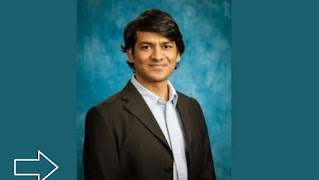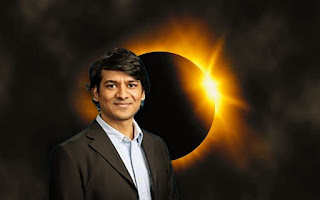Aroh Barjatya, a name synonymous with innovation and excellence in the aerospace industry, has been making significant strides in leading NASA missions and shaping the future of space exploration. With a rich background in engineering and a relentless pursuit of knowledge, Barjatya stands as a beacon of inspiration for aspiring scientists and engineers worldwide.
Born and raised in India, Barjatya's journey into the realm of aerospace engineering began with a passion for understanding the mysteries of the universe. Growing up in a family with a strong engineering background, with his father, Ashok Kumar Barjatya, a chemical engineer, and his mother, Rajeshwari, a homemaker, Barjatya was exposed to the wonders of science from an early age.His educational journey commenced in India, where he received his early schooling in various cities, including Patalganga near Mumbai, Pilani, Jaipur, Solapur, and Hyderabad. It was during these formative years that Barjatya developed a keen interest in electronics engineering, laying the foundation for his future endeavors in the field.
After completing his schooling, Barjatya pursued a degree in electronics engineering from the prestigious Walchand Institute of Technology in Solapur. Armed with a strong academic foundation and a thirst for knowledge, he embarked on a transformative journey to the United States in 2001 to further his education and pursue his dreams in aerospace engineering.
Barjatya's academic pursuits led him to Utah State University, where he obtained his Master's degree in electrical and electronics engineering. It was during his time at Utah State University that Barjatya's passion for space exploration ignited, prompting him to delve deeper into the realm of spacecraft instrumentation.
Fuelled by his desire to push the boundaries of human knowledge and explore the uncharted territories of space, Barjatya embarked on a remarkable academic journey, culminating in the attainment of his Ph.D. in spacecraft instrumentation from the Utah State University Research Foundation. This milestone marked the beginning of Barjatya's illustrious career in aerospace engineering, setting the stage for his groundbreaking contributions to the field.
With over 16 years of experience in space systems engineering and aerospace instrumentation research, Barjatya has established himself as a trailblazer in the aerospace industry. His expertise encompasses a wide range of areas, including high-altitude balloons, CubeSats, space situational awareness, and embedded electronics, showcasing his versatility and ingenuity in tackling complex aerospace challenges.
Currently serving as a professor of Engineering Physics and Director of the Space and Atmospheric Instrumentation Lab at Embry-Riddle Aeronautical University (ERAU), Barjatya plays a pivotal role in shaping the next generation of aerospace engineers and scientists. His dedication to fostering innovation and excellence in aerospace education has earned him widespread recognition and admiration within the academic community.
One of Barjatya's most notable achievements came in the form of spearheading a NASA mission during the solar eclipse on April 8, 2024. The mission, named Atmospheric Perturbations around Eclipse Path (APEP), saw the launch of three sounding rockets from NASA's Wallops Flight Facility in Virginia. These rockets were designed to carry out scientific experiments aimed at studying the effects of the eclipse on Earth's upper atmosphere, providing invaluable insights for atmospheric research.
The successful execution of the APEP mission underscored Barjatya's leadership and technical prowess, further solidifying his reputation as a leading figure in the aerospace industry. His unwavering commitment to pushing the boundaries of scientific exploration and his ability to navigate the complexities of space missions have earned him accolades and admiration from peers and colleagues alike.Beyond his professional achievements, Barjatya remains deeply committed to continuous learning and personal growth. His pursuit of excellence extends beyond the confines of academia, as evidenced by his dedication to mastering complex systems and methodologies through certifications from the MIT School of Engineering.
In addition to his academic pursuits, Barjatya is a devoted family man, drawing inspiration from his familial roots and upbringing. His sister, Apurva Barjatya, a mechanical engineer, shares his passion for engineering and serves as a constant source of support and encouragement in his journey.
As Barjatya continues to chart new frontiers in aerospace engineering and inspire future generations of scientists and engineers, his contributions to the field of space exploration remain invaluable. His unwavering dedication to advancing human knowledge and his visionary leadership serve as a testament to the limitless potential of the human spirit and its capacity for exploration and discovery.
In a world where the boundaries of space are constantly being redefined, Aroh Barjatya stands as a shining example of what can be achieved through passion, perseverance, and an unyielding commitment to excellence. As he continues to push the boundaries of scientific exploration and shape the future of space exploration, Barjatya's legacy will undoubtedly endure as a beacon of inspiration for generations to come.
FAQS:
1. Who is Aroh Barjatya?
Aroh Barjatya is an Indian-origin aerospace engineer and professor known for his contributions to NASA missions and aerospace research.
2. What is Aroh Barjatya's educational background?
Barjatya holds a Master's degree in electrical and electronics engineering and a Ph.D. in spacecraft instrumentation from Utah State University.
3. Where does Aroh Barjatya work?
Currently, Barjatya serves as a professor of Engineering Physics and Director of the Space and Atmospheric Instrumentation Lab at Embry-Riddle Aeronautical University (ERAU).
4. What are some of Aroh Barjatya's notable achievements?
Barjatya spearheaded a recent NASA mission during the solar eclipse on April 8, 2024, where three sounding rockets were launched to study the effects of the eclipse on Earth's upper atmosphere.
5. What is Barjatya's expertise in aerospace engineering?
Barjatya has over 16 years of experience in space systems engineering and aerospace instrumentation research. His expertise includes high-altitude balloons, CubeSats, space situational awareness, and embedded electronics.
6. Has Aroh Barjatya received any certifications?
Yes, Barjatya holds certifications from the MIT School of Engineering in Architecture and Systems Engineering, showcasing his dedication to mastering complex systems and methodologies.
7. What is Barjatya's family background?
Barjatya comes from a family with a strong engineering background. His father is a chemical engineer, and his sister is a mechanical engineer, reflecting a familial influence on his career path.
8. What motivates Aroh Barjatya in his aerospace pursuits?
Barjatya's passion for space exploration and his desire to push the boundaries of human knowledge serve as primary motivations in his aerospace endeavors.
9. How does Aroh Barjatya contribute to the aerospace community beyond his academic role?
In addition to his academic responsibilities, Barjatya actively participates in groundbreaking aerospace initiatives and missions, showcasing his commitment to advancing the field of aerospace engineering.
10. What is Aroh Barjatya's vision for the future of space exploration?
Barjatya envisions a future where space exploration continues to expand, enabling humanity to unravel the mysteries of the universe and pave the way for further scientific discoveries and advancements.


